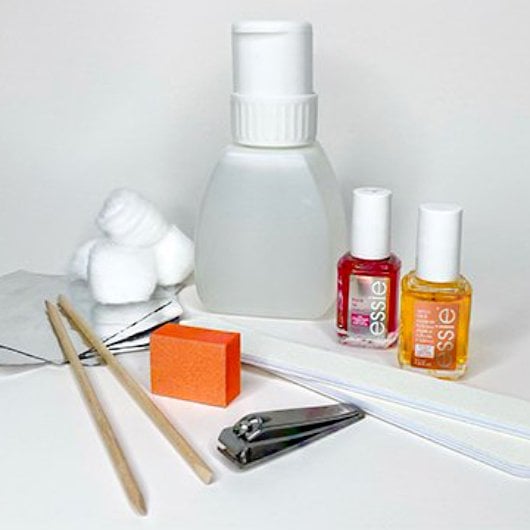what you need for removing gel nail polish
-
removal supplies
-
post removal treatments
- 1 paper towels
- 2 nail file (180 grit)
- 3 100% pure acetone
- 4 cotton balls or rounds
- 5 tin foil: cut into 3-inch squares, one for each finger
- 6 orangewood stick or cuticle pusher
- 7 nail buffer (240 grit or higher)
- 8 essie apricot cuticle oil
- 9 timer

- 1 nail clipper
- 2 hard to resist advanced nail strengthener
- 3 to the rescue UV gel damage repair nail treatment

trim nails
file gel surface
protect your cuticles
soak nails in acetone & wrap
soak nails in acetone & wrap
wait 10-15 minutes
check the foils
remove the gel
remove the gel
buff nails
hydrate and treat
hydrate and treat
common mistakes when removing gel nail polish
removing gel nails at home requires a bit of patience. one of the most common mistakes is not soaking long enough, so set a timer and check one nail before taking off all the foils. but don’t wait too long either: acetone only removes most of the gel polish, no matter how long it stays on.
another important thing to keep in mind is your nails are extra fragile after the gel nail application process. do not use any sharp objects on your nails and be more gentle than usual until they get healthy and strong.
what to know about gel nails and gel removal
water passes through our nails at about half the rate when we wear a coating like gel or acrylic. after removing gel nail polish, it’s common for nails to feel slightly softer because they’re in a different state. give your nails 24 hours to return to normal.
now that you’ve removed your gel nails, consider a gentler alternative to UV gel manicures that looks just as great: essie gel couture longwear nail polish. our 2-step system provides long 15-day wear and a gel-like shine, but it comes off like regular nail polish.
please also note that not all gels are created equal.
- - hard gels can only be filed off, preferably by a professional manicurist.
- - if you’re wearing builder or BIAB gel along with gel polish, it’s important to file down a lot more of the gel thickness before soaking with acetone. this will speed up the removal process.
once you’ve followed all the steps for removing gel nails at home, be sure to reset your natural nails by making them stronger, healthier and moisturized. apply a nail strengthener or treatment and a cuticle oil. they’re your best allies for getting your nails back in shape.
